
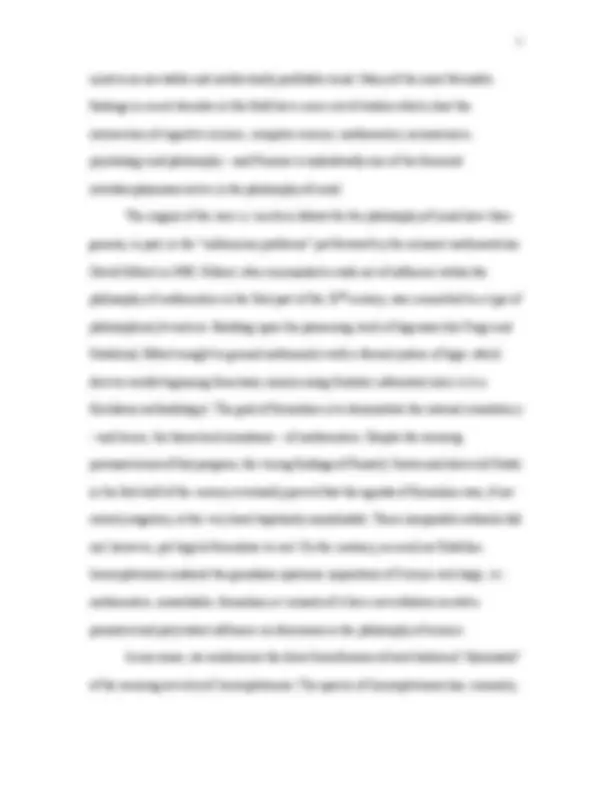
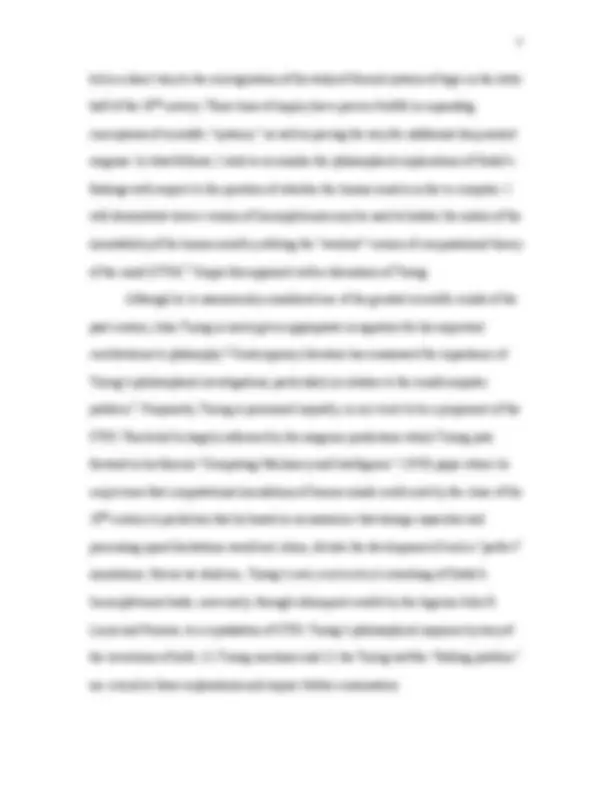
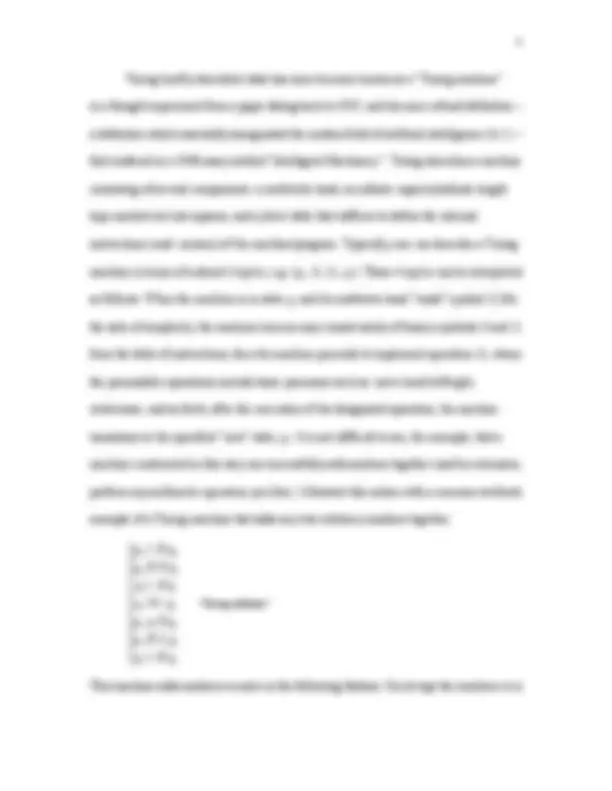
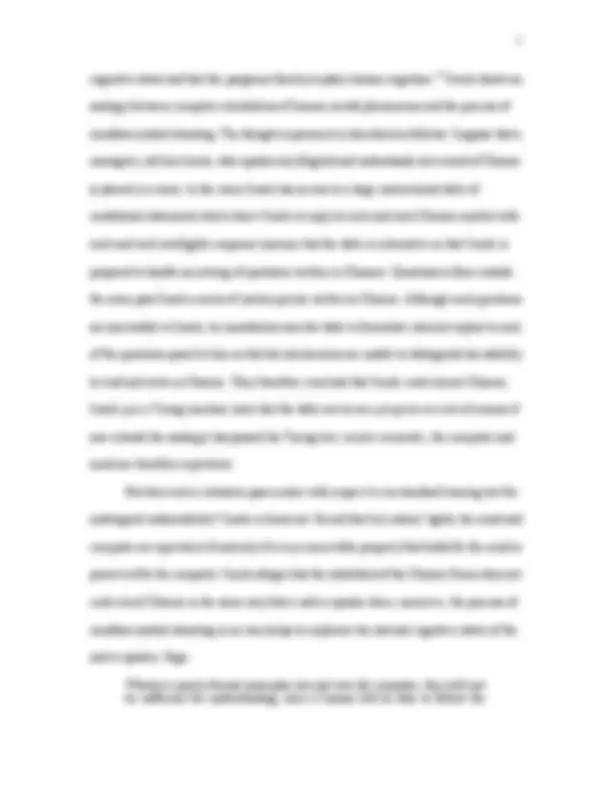
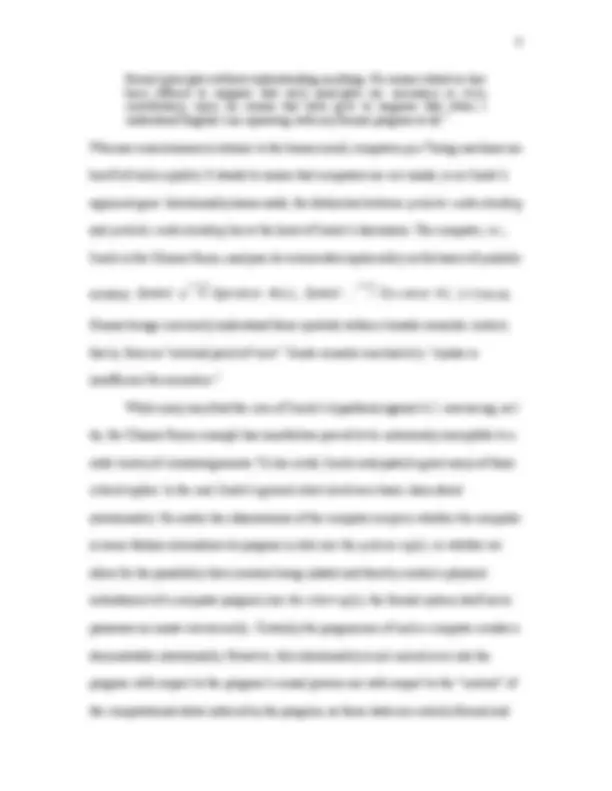
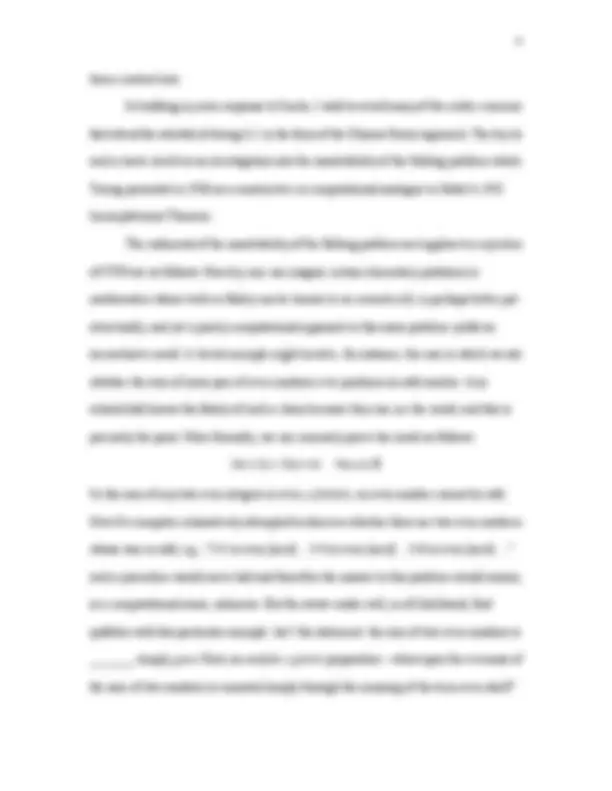
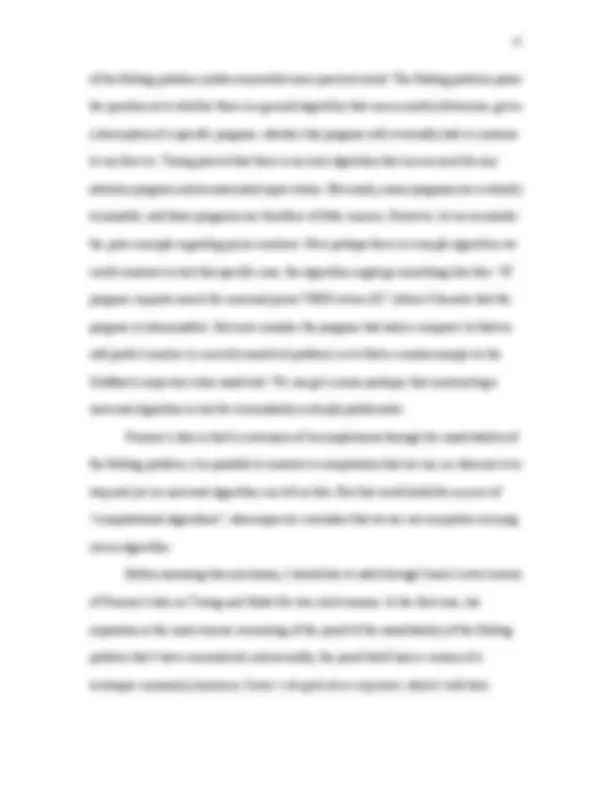
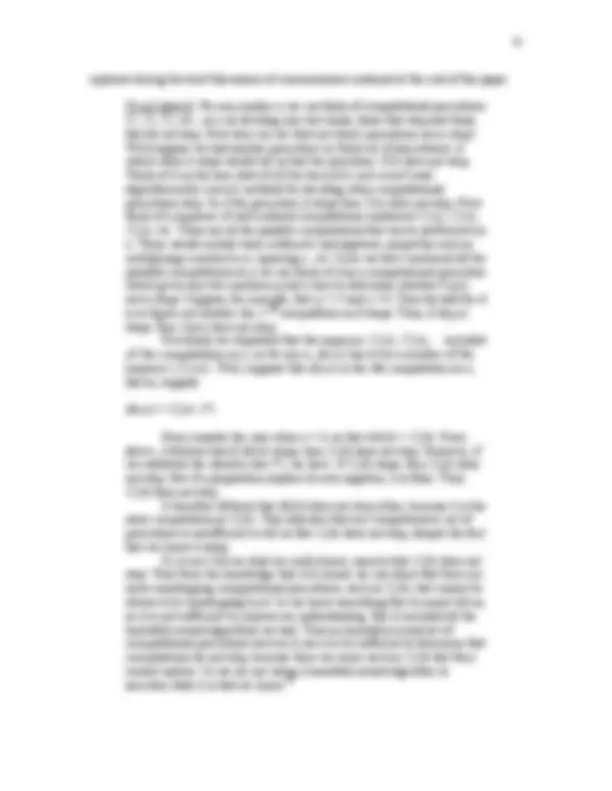
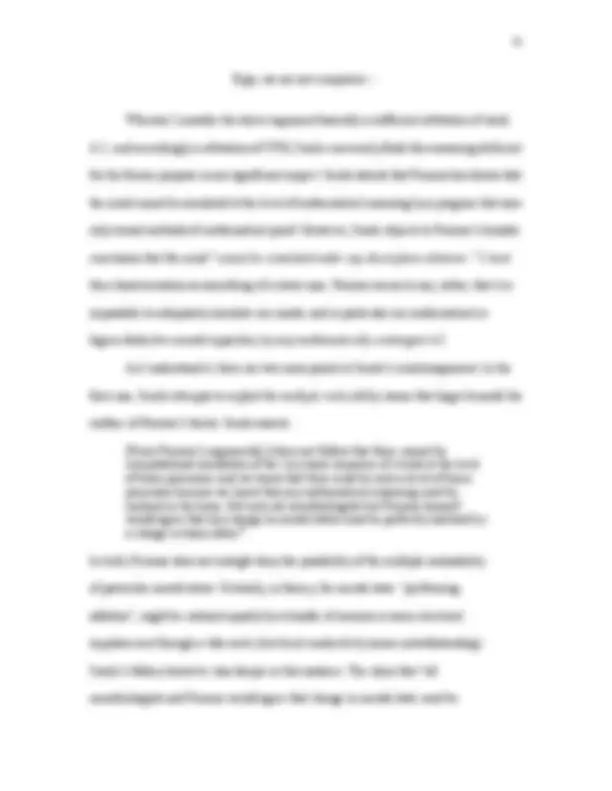
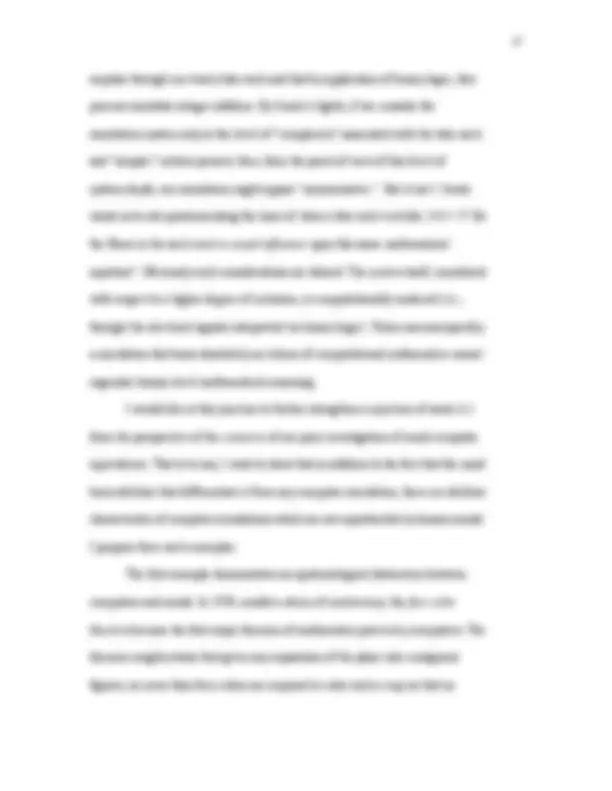
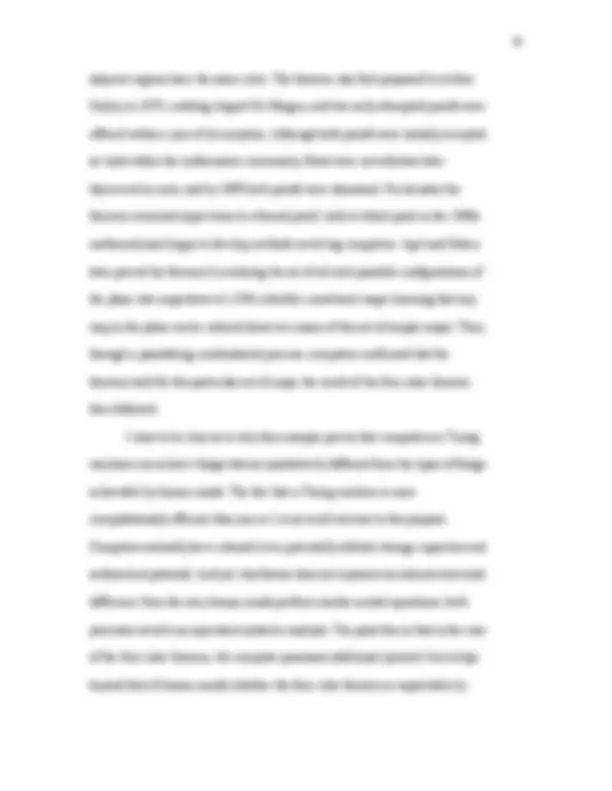
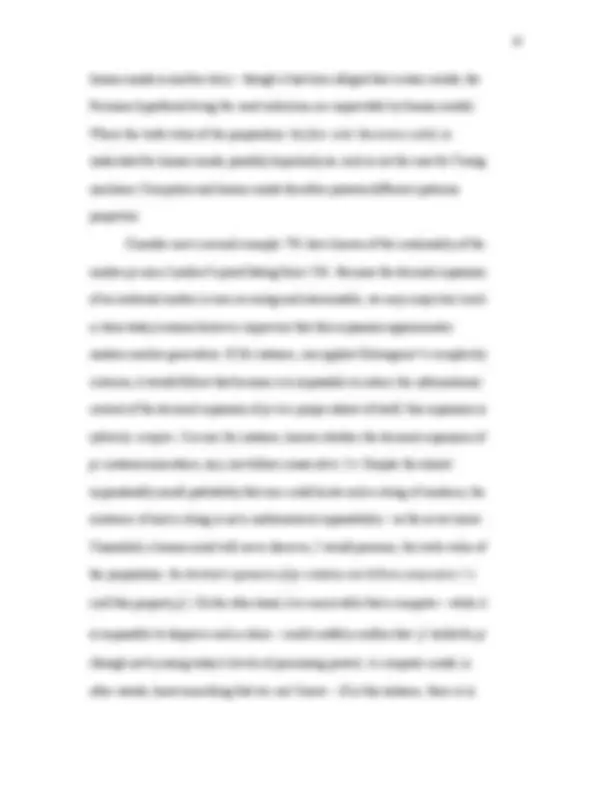
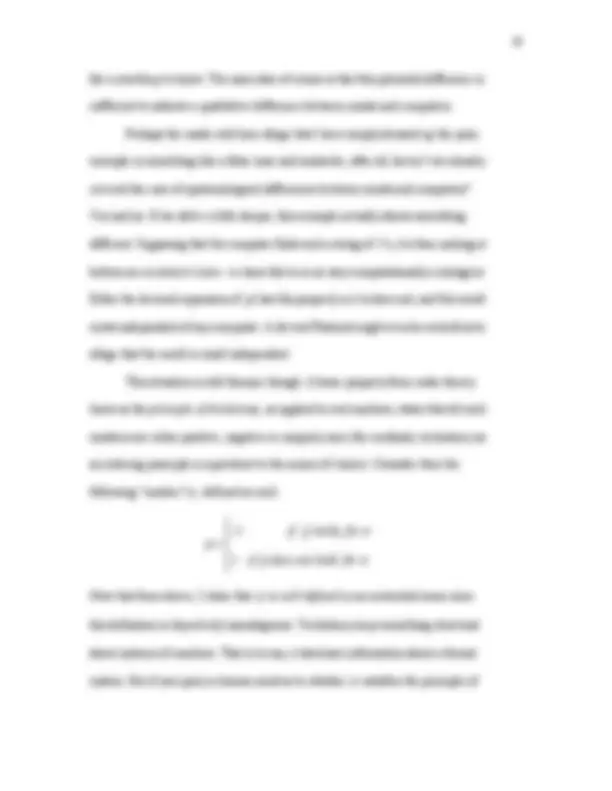
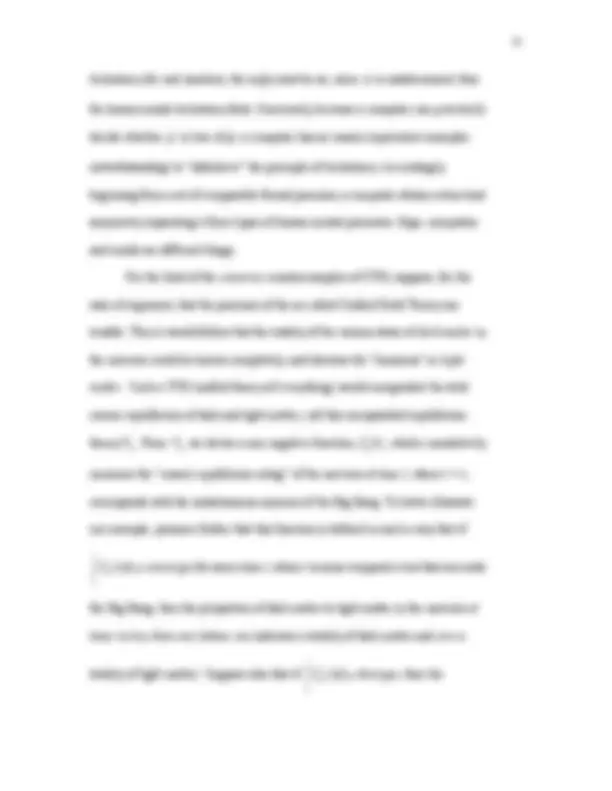
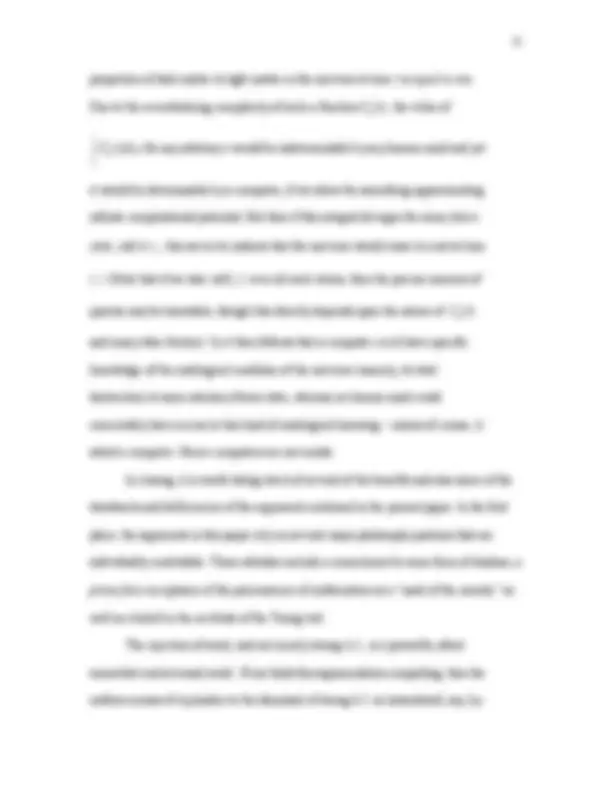
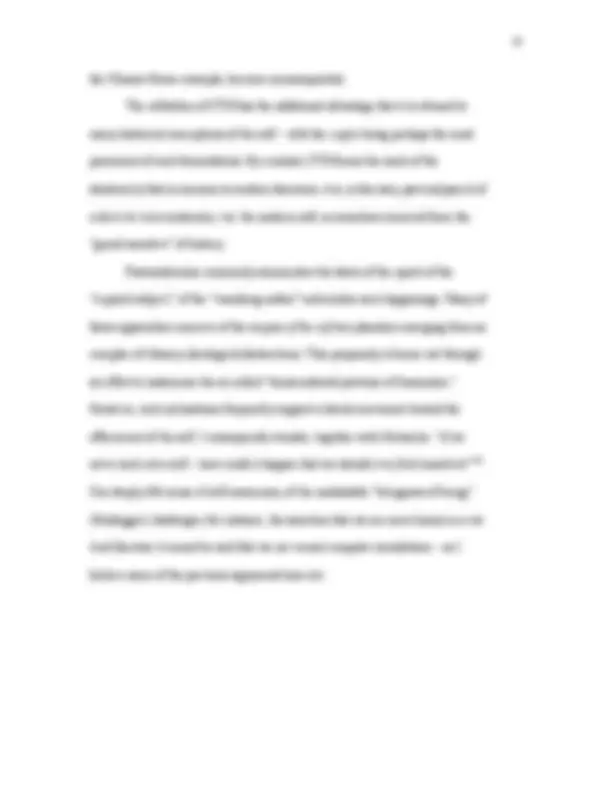
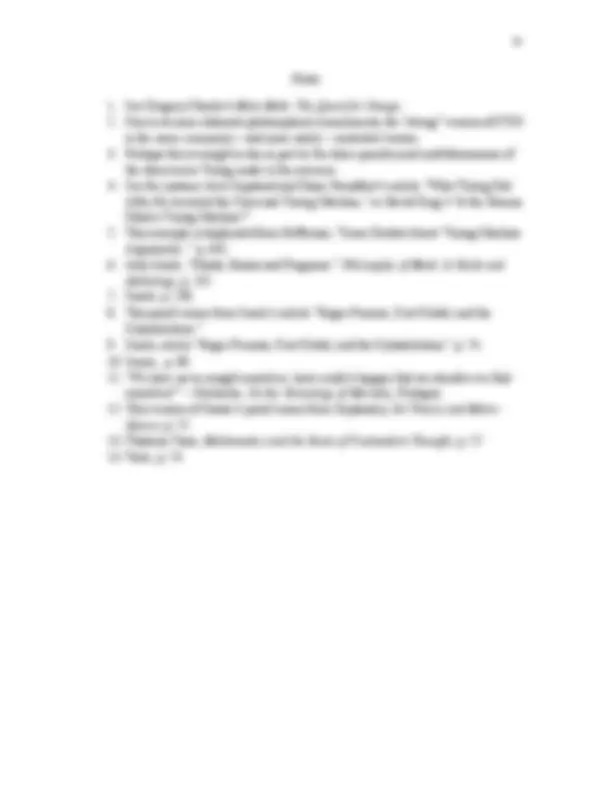
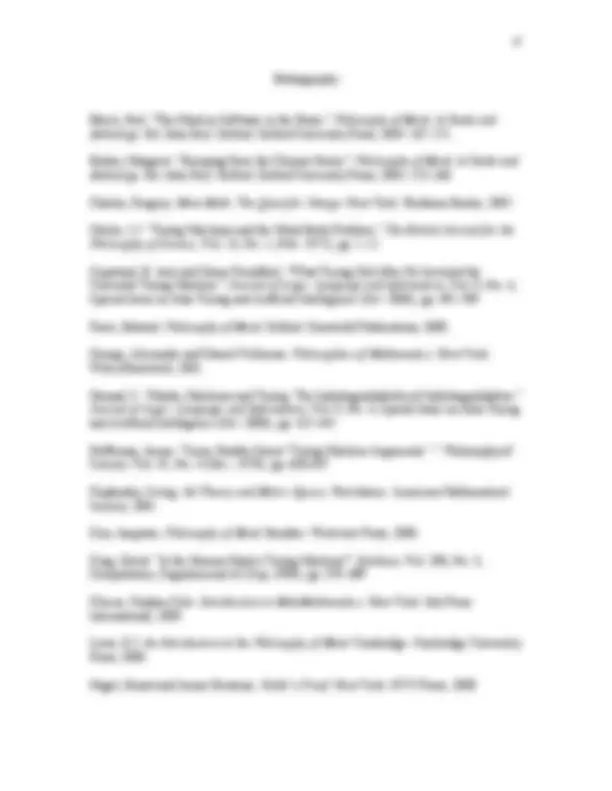
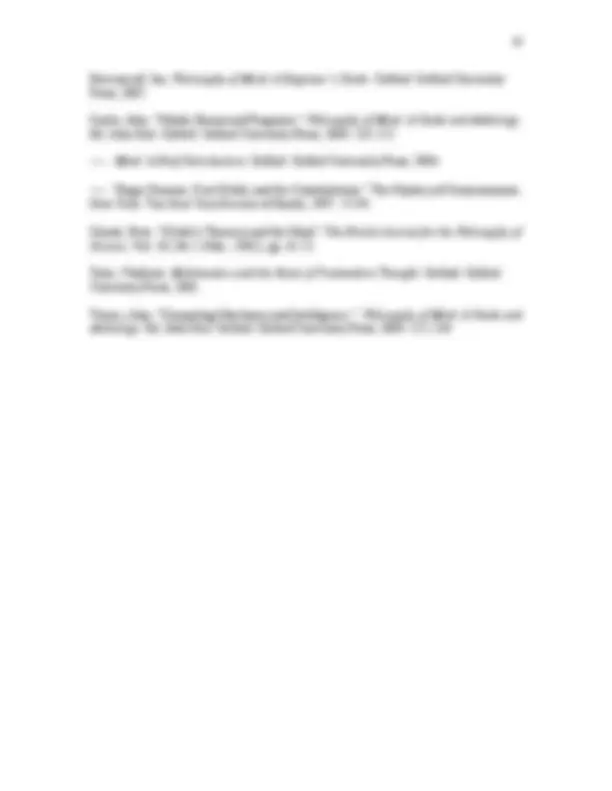


Study with the several resources on Docsity

Earn points by helping other students or get them with a premium plan


Prepare for your exams
Study with the several resources on Docsity

Earn points to download
Earn points by helping other students or get them with a premium plan
Community
Ask the community for help and clear up your study doubts
Discover the best universities in your country according to Docsity users
Free resources
Download our free guides on studying techniques, anxiety management strategies, and thesis advice from Docsity tutors
The goal of formalism is to demonstrate the internal consistency and hence, the theoretical soundness of mathematics.
Typology: Study notes
1 / 27

This page cannot be seen from the preview
Don't miss anything!




















Portland State University, 2011
“The Whole Dignity of Man Lies in His Thought”
In the last century, the debate over the nature of the mind has enjoyed a renewed
prominence and relevance. Gregory Chaitin has, for instance, recently made the bold claim
that the pure Gedankenexperiments provided by philosophers of mind in the 20th^ century
directly engendered one of mankind’s crowning intellectual achievements: the invention of
the computer.^1 For the purposes of this paper, my interests lie in assessing and critiquing
the current debate centering around the question prompted by the aforementioned
genealogy of ideas, namely: is the human mind a computer? It is likely that the answer to
this question will have an important impact upon considerations in the philosophy of mind
as well as conceptions of the nature of the self over the course of the next century.
I will use an article published by the preeminent philosopher of mind, John Searle,
entitled “Roger Penrose, Kurt Gödel, and Cytoskeletons” (1997) as my main point-of-entry
into the “computational theory of mind” (i.e. the theory that human minds are essentially
equivalent to computational machines ) discussion. Searle is well-known for his attempted
refutation of the core premises of the computational theory of the mind, known as the
“Chinese Room” thought experiment (c. 1980). In the present paper I wish to focus on
arguments that spawn from the theses of the Chinese Room argument, particularly with
regard to Searle’s more recent musings on Penrose and Gödel. Using concrete
mathematical and logico-deductive tools, Searle’s work on Penrose and Gödel frames the
computational theory of the mind problem more cogently than many of the more
theoretically informal or purely speculatively studies on this topic. The tropism toward a
disciplinary inclusiveness with regard to investigations into questions in the philosophy of
led in a direct way to the reinvigoration of the study of formal systems of logic in the latter
half of the 20th^ century. These lines of inquiry have proven fruitful in expanding
conceptions of scientific “systems,” as well as paving the way for additional deep-seated
enigmas. In what follows, I wish to reconsider the philosophical implications of Gödel’s
findings with respect to the question of whether the human mind is in fact a computer. I
will demonstrate how a version of Incompleteness may be used to bolster the notion of the
inimitability of the human mind by refuting the “weakest” version of computational theory
of the mind (CTM).^2 I begin this approach with a discussion of Turing.
Although he is unanimously considered one of the greatest scientific minds of the
past century, Alan Turing is rarely given appropriate recognition for his important
contributions to philosophy.^3 Contemporary literature has reassessed the importance of
Turing‘s philosophical investigations, particularly in relation to the mind/computer
problem.^4 Frequently, Turing is presumed (unjustly, in my view) to be a proponent of the
CTM. This belief is largely informed by the sanguine predictions which Turing puts
forward in his famous “Computing Machinery and Intelligence” (1950) paper where he
conjectures that computational simulations of human minds could exist by the close of the
20 th^ century (a prediction that he based on an assurance that storage capacities and
processing speed limitations would not, alone, obviate the development of such a “perfect”
simulation). But as we shall see, Turing’s own constructivist reworking of Gödel’s
Incompleteness leads, conversely, through subsequent results by the logician John R.
Lucas and Penrose, to a repudiation of CTM. Turing’s philosophical inquiries by way of
the inventions of both: (1) Turing machines and (2) the Turing test/the “Halting problem”
are crucial to these explorations and require further examination.
Turing briefly described what has since become known as a “Turing machine”
in a thought experiment from a paper dating back to 1937, and his more refined definition –
a definition which essentially inaugurated the modern field of artificial intelligence (A.I.) –
first surfaced in a 1948 essay entitled “Intelligent Machinery.” Turing describes a machine
consisting of several components: a read/write head, an infinite capacity/infinite length
tape marked out into squares, and a finite table that suffices to define the internal
instructions (read: axioms) of the machine/program. Typically, one can describe a Turing
machine in terms of ordered 4 - tuples , e.g. ( q 1 , Sr, Os, q 2 ). These 4 - tuples can be interpreted
as follows: When the machine is in state q 1 and its read/write head “reads” symbol Sr (for
the sake of simplicity, the machine-lexicon may consist solely of binary symbols 0 and 1 )
from the table of instructions, then the machine proceeds to implement operation Os , where
the permissible operations include basic processes such as: move head left/right,
write/erase, and so forth; after the execution of the designated operation, the machine
transitions to the specified “new” state, q 2. It is not difficult to see, for example, that a
machine constructed in this way can successfully add numbers together (and by extension,
perform any arithmetic operation you like). I illustrate this notion with a common textbook
example of a Turing machine that adds any two arbitrary numbers together.
0 0 0 1 1 1 1 2 2 2 2 3 3 3
q B q q B R q q R q q q q q R q q B L q q B q
“Turing addition”
This machine adds numbers m and n in the following fashion: On its tape the numbers m (a
consciousness and other mental phenomena consist entirely in computational processes.
Weak A.I. , conversely, requires that brain processes cause consciousness, and these
processes can be potentially simulated on a computer. The remaining positions, the third of
which Penrose endorses, consist in the notion that brain processes cause consciousness but
these processes “cannot even be properly simulated computationally”, while the last
position (which I do no pursue in this paper) alleges that science cannot explain
consciousness.
Before I unpack Searle’s position (he concedes the legitimacy of weak A.I. but not
strong A.I.) I want to first clarify the manner in which I propose to appraise CTM from an
ontological point of view. After all, if CTM suggests that the mind and computer are
equivalent , what here is meant by equivalent? Leibniz’ principle of the identity of
indiscernibles provides a sound way to check the purported equivalence of mind and
computer upheld by CTM. This criterion is arguably the most widely-accepted principle
relating to the assignation of ontological equivalence. The identity of indiscernibles states
that two entities are identical if they have all conceivable (which is to say not merely
empirical) properties in common. Stated more formally, then: if, for every property F ,
object x has F if and only if object y has F , then x is identical to y ; alternatively, in the
language of symbolic logic we have: F Fx ( Fy ) x y. Let us now apply this
analytic standard to the claims made by CTM in order to illuminate Searle’s approach,
beginning with the famous Chinese Room argument.
Searle presents his arguments in the article “Minds, Brains and Programs” (1980).
From the outset, he makes clear his position against weak A.I.: “my discussion [is] directed
[against the specific] claim that the appropriately programmed computer literally has
cognitive states and that the programs thereby explain human cognition.”^6 Searle draws an
analogy between computer simulations of human mental phenomena and the process of
mindless symbol shunting. The thought experiment is described as follows: Suppose that a
monoglot, call him Searle, who speaks only English and understands not a word of Chinese
is placed in a room. In the room Searle has access to a large instructional table of
conditional statements which direct Searle to reply to such and such Chinese symbol with
such and such intelligible response (assume that the table is exhaustive so that Searle is
prepared to handle any string of questions written in Chinese). Questioners from outside
the room pass Searle a series of yes/no queries written in Chinese. Although such questions
are inscrutable to Searle, he nonetheless uses the table to formulate coherent replies to each
of the questions posed to him so that his interlocutors are unable to distinguish his inability
to read and write in Chinese. They therefore conclude that Searle understands Chinese;
Searle qua a Turing machine (note that the table serves as a program or a set of axioms if
one extends the analogy) has passed the Turing test; mutatis mutandis , the computer and
mind are therefore equivalent.
But does such a situation pass muster with respect to our standard-bearing test for
ontological indisernibility? Searle reckons not. Recall that by Leibniz’ lights, the mind and
computer are equivalent if and only if every conceivable property that holds for the mind is
preserved for the computer. Searle alleges that the inhabitant of the Chinese Room does not
understand Chinese in the same way that a native speaker does; moreover, the process of
mindless symbol shunting in no way helps to explicate the internal cognitive states of the
native speaker. Ergo:
Whatever purely formal principles you put into [a] computer, they will not be sufficient for understanding, since a human will be able to follow the
hence content-less.
In building my own response to Searle, I wish to avoid many of the eristic concerns
that attend the rebuttal of strong A.I. in the form of the Chinese Room argument. The key to
such a tactic involves an investigation into the unsolvability of the Halting problem which
Turing presented in 1936 as a constructive or computational analogue to Gödel’s 1931
Incompleteness Theorem.
The rudiments of the unsolvability of the Halting problem as it applies to a rejection
of CTM are as follows. Naively, one can imagine certain elementary problems in
mathematics whose truth or falsity can be known to us semantically or perhaps better put:
structurally, and yet a purely computational approach to this same problem yields an
inconclusive result. A trivial example might involve, for instance, the case in which we ask
whether the sum of some pair of even numbers ever produces an odd number. Any
schoolchild knows the falsity of such a claim because they can see the result, and this is
precisely the point. More formally, we can concisely prove the result as follows:
2 m 2 n 2( m n ) m n , Z
So the sum of any two even integers is even; a fortiori , an even number cannot be odd.
Now if a computer exhaustively attempted to discover whether there are two even numbers
whose sum is odd, e.g., “2+2 is even [next]…2+4 is even [next]…2+6 is even [next]…”
such a procedure would never halt and therefore the answer to this problem would remain,
in a computational sense, unknown. But the astute reader will, in all likelihood, find
quibbles with this particular example. Isn’t the statement: the sum of two even numbers is
_______, simply, pace Kant, an analytic a priori proposition – whereupon the evenness of
the sum of two numbers is connoted simply through the meaning of the term even itself?
Certainly such a criticism is perfectly valid. Yet things aren’t quite as simple if we devise a
more intricate problem.
Take as a second example a question regarding prime numbers. Bear in mind that a
prime numbers is any integer, call it p, that is greater than or equal to two and whose only
positive divisors are p, itself, and the number one. Now prime numbers are important for all
sorts of reasons – but at this juncture let us simply ask, as many have wondered before: are
there an infinite number of primes? The answer, which, to the best of anyone’s knowledge
first dates to Euclid, is a resounding yes. Notice that this result is less apparent than the
previous example; we might, in the language of Kant, term it a synthetic a priori
proposition. The idea is that it takes a bit more work in order to see the truth in the assertion
that there are an infinite number of primes. Euclid proposed the following argument:
Proof: Suppose not, and allow that there are only a finite number of primes: {p 1 ,p 2 ,p 3 ,…,pn}. Define the number p * = p 1 p 2 p 3 ...pn + 1, which is to say p * equals the product of all primes plus one. Then we are faced with two possibilities. Either p * is prime, in which case our original finite set of primes is incomplete, a contradiction; otherwise, p * is composite (non-prime) whereby the fundamental theorem of algebra guarantees that it is divisible by some prime number – but this too is a contradiction because p * is not divisible by any prime by its very construction. Consequently, by the method of reductio ad absurdum, there exist an infinite number of primes.
Just as in the previous example with even numbers, the truth or falsity of a
mathematical proposition may require extrinsic or special structural knowledge of the
given elements at hand in addition to information about the relational properties of these
entities in order to ascertain a definitive result. With the prime number example, we are, I
think, advancing closer to the line of demarcation between what is mentally possible and
that which is computationally impossible; since this problem, for instance, offers no simple
of the Halting problem yields a somewhat more practical result. The Halting problem poses
the question as to whether there is a general algorithm that can accurately determine, given
a description of a specific program, whether this program will eventually halt or continue
to run forever. Turing proved that there is no such algorithm that can account for any
arbitrary program and its associated input values. Obviously, many programs are evidently
terminable; and these programs are therefore of little concern. However, let us reconsider
the prior example regarding prime numbers. Now perhaps there is a simple algorithm we
could construct to test this specific case; the algorithm might go something like this: “IF
program requests search for maximal prime THEN return (0)” (where 0 denotes that the
program is interminable). But now consider the program that asks a computer to find an
odd perfect number (a currently unsolved problem) or to find a counterexample to the
Goldbach conjecture (also unsolved). We can get a sense perhaps, that constructing a
universal algorithm to test for terminability is deeply problematic.
Penrose’s idea is that by extension of Incompleteness through the unsolvability of
the Halting problem, it is possible to construct a computation that we can see does not ever
stop and yet no universal algorithm can tell us this. But this result holds for any set of
“computational algorithms”; whereupon he concludes that we are not computers carrying
out an algorithm.
Before assessing this conclusion, I would like to walk through Searle’s own version
of Penrose’s take on Turing and Gödel for two chief reasons. In the first case, his
exposition is the most concise recounting of the proof of the unsolvability of the Halting
problem that I have encountered; and secondly, the proof itself uses a version of a
technique commonly known as Cantor’s diagolization argument , which I will later
replicate during the brief discussion of consciousness contained at the end of this paper.
Proof (sketch) : For any number n we can think of computational procedures C 1 , C 2 , C 3 , etc., on n as dividing into two kinds, those that stop and those that do not stop. Now how can we find out which procedures never stop? Well suppose we had another procedure (or finite set of procedures) A which when it stops would tell us that the procedure C ( n ) does not stop. Think of A as the sum total of all the knowable and sound (read: algorithmically correct) methods for deciding when computational procedures stop. So if the procedure A stops then C ( n ) does not stop. Now think of a sequence of well-ordered computations numbered C 1 ( n ), C 2 ( n ), C 3 ( n ), etc. These are all the possible computations that can be performed on n. These would include basic arithmetic and algebraic properties such as multiplying a number by n , squaring n ., etc. Since we have numbered all the possible computations on n we can think of A as a computational procedure which given any two numbers q and n tries to determine whether C q ( n ) never stops. Suppose, for example, that q = 17 and n = 8. Then the task for A is to figure out whether the 17th^ computation on 8 stops. Thus, if A ( q , n ) stops, then Cq ( n ) does not stop. Previously we stipulated that the sequence C 1 ( n ), C 2 ( n ),… included all the computations on n , so for any n , A ( n,n ) has to be a member of the sequence { Cn ( n )}. Well, suppose that A ( n,n ) is the k th computation on n , that is, suppose A ( n,n ) = Ck ( n ). (*)
Now consider the case when n = k , so that A ( k,k ) = Ck ( k ). From above, it follows that if A ( k,k ) stops, then Ck ( k ) does not stop. However, if we substitute the identity into (*), we have: if Ck ( k ) stops, then Ck ( k ) does not stop. But if a proposition implies its own negation, it is false. Thus: Ck ( k ) does not stop. It therefore follows that A ( k,k ) does not stop either, because it is the same computation as Ck ( k ). This indicates that our comprehensive set of procedures is insufficient to tell us that Ck ( k ) does not stop, despite the fact that we know it stops. So A can’t tell us what we really know, namely that Ck ( k ) does not stop. Thus from the knowledge that A is sound, we can show that there are some nonstopping computational procedures, such as Ck ( k ), that cannot be shown to be nonstopping by A. So we know something that A cannot tell us, so A is not sufficient to express our understanding. But A included all the knowably sound algorithms we had. Thus no knowably sound set of computational procedures such as A can ever be sufficient to determine that computations do not stop, because there are some such as Ck ( k ) that they cannot capture. So we are not using a knowably sound algorithm to ascertain what it is that we know. 8
perfectly matched by a change in brain states” commits Searle to an irrevocable
contradiction. Remember that Searle agrees, along with Penrose, that strong A.I. is
infeasible, so that he claims that mental phenomena in total cannot be properly
simulated by a computer. But Searle seems to suggest in the preceding comment
that there can be a perfect, isomorphic mapping between mental states and brain
states. This belief is incompatible with a rejection of strong A.I. If the hypothesis of
strong A.I. is false, then brain states are not equivalent to mental states (for if they
were, an ideal physical model of the brain would satisfy the conditions of strong
A.I.); and if brain states are different from mental states then Searle is a committed
dualist and his statement above is nonsensical.
I likewise reject Searle’s second rejoinder to Penrose. Searle explains his
reasoning:
He [Penrose] thinks he has shown that you could not program a robot to do all the mathematical reasoning that human beings are capable of. But once again that claim has to be qualified. He has, if he is right, shown that you could not program a robot to do human-level mathematical reasoning if you programmed it solely with algorithmic mathematical reasoning programs. But suppose that you programmed it solely with totally nonnormative brain simulator programs. There is no question of ‘truth judgments’ or ‘soundness’ in the programs. Nothing in his argument shows that ‘human-level mathematical reasoning’ could not emerge as a product of the robot’s brain simulator program, just as it emerges as a product of actual human brains…From the fact that we cannot simulate a process at the level of, and under the description, ‘theorem proving’ or mathematical reasoning’ it does not follow that we cannot simulate the very same process, with the same predictions, at some other level and under another description.^10
Searle’s comments strike me as more of a semantic diversion than a substantive
philosophical objection. I am not at all opposed to utilizing thought experiments of
varying degrees of plausibility in the course of one’s reasoning – indeed, without
such experiments many of the most important developments in philosophy and the
sciences would have been otherwise unattainable. Even so, it is not at all clear to
me that the “nonnormative brain simulators” which Searle references above are the
least bit conceivable. Other than denoting something antithetical to what we
envisage as a “computer” today, what does this mean? Perhaps sensing the
flimsiness of his rebuke of Penrose, Searle admits such a thought is akin to “science
fiction fantasy.” Fictional though they may be, thought experiments (at least the
compelling ones) must bear some manner of existential constituents ; we must be
able to portray them in terms that go beyond a mere vacuous semantic husk. Where
Penrose conveys the rough correlation “mind implies mathematical-reasoning
aptitude”; Searle seems to me, by contrast, to effectively scream “nonnormative!”
in a crowded theater of mathematicians and neuroscientists. Not only is his
comment openly specious, it is, moreover, something of a philosophical non
sequitur.
These qualms aside, Searle’s criticism is also faulty on the level of analytic
depth. He maintains that Penrose fails to prove that non-computational processes
could not give rise to simulated, human-level mathematical reasoning. So then a
counterexample to Penrose’s thesis, which Searle entertains, would imply that
human-level mathematical reasoning could exist within a system of mental states
(or some process approximating mental states) that is systemically
non-computational; in other words, such an embedding of processes are each or in
total, devoid of any semblance of computational mathematics – at any depth. But
then suppose, for the sake of argument, that we are once again sending an electrical
adjacent regions have the same color. The theorem was first proposed by Arthur
Cayley in 1879, crediting August De Morgan, and two early attempted proofs were
offered within a year of its inception. Although both proofs were initially accepted
as valid within the mathematics community, flaws were nevertheless later
discovered in each, and by 1890 both proofs were dismissed. For decades the
theorem remained impervious to a formal proof, until at which point in the 1960s
mathematicians began to develop methods involving computers. Apel and Haken
later proved the theorem by reducing the set of all such possible configurations of
the plane into maps down to 1,936 reducible constituent maps (meaning that any
map in the plane can be reduced down to a union of this set of simple maps). Then,
through a painstaking combinatorial process, computers confirmed that the
theorem held for this particular set of maps; the result of the four color theorem
then followed.
I want to be clear as to why this example proves that computers or Turing
machines can achieve things that are qualitatively different from the types of things
achievable by human minds. The fact that a Turing machine is more
computationally efficient than you or I is not at all relevant to this purpose.
Computers naturally have colossal (even potentially infinite) storage capacities and
arithmetical potential. And yet, this feature does not represent an inherent structural
difference from the way human minds perform similar mental operations; both
processes involve an equivalent syntactic analysis. The point then is that in the case
of the four color theorem, the computer possesses additional (present) knowledge
beyond that of human minds (whether the four color theorem is unprovable by
human minds is another story – though it has been alleged that certain results, the
Reimann hypothesis being the most notorious, are unprovable by human minds).
Where the truth-value of the proposition: the four color theorem is valid , is
undecided for human minds, possibly hopelessly so, such is not the case for Turing
machines. Computers and human minds therefore possess different epistemic
properties.
Consider now a second example. We have known of the irrationality of the
number pi since Lambert’s proof dating from 1761. Because the decimal expansion
of an irrational number is non-recurring and interminable, we may conjecture (such
a claim today remains however unproven) that this expansion approximates
random number generation. If, for instance, one applies Kolmogorov’s complexity
criterion, it would follow that because it is impossible to reduce the informational
content of the decimal expansion of pi to a proper subset of itself, this expansion is
infinitely complex. It is not, for instance, known whether the decimal expansion of
pi contains somewhere, say, one billion consecutive 1 ’s. Despite the almost
imponderably small probability that one could locate such a string of numbers, the
existence of such a string is not a mathematical impossibility – so far as we know.
Unassisted, a human mind will never discover, I would presume, the truth-value of
the proposition: the decimal expansion of pi contains one billion consecutive 1’s
(call this property p ˆ ). On the other hand, it is conceivable that a computer – while it
is impossible to disprove such a claim – could credibly confirm that p ˆ holds for pi
(though not by using today’s levels of processing power). A computer could, in
other words, know something that we can’t know – if in this instance, there is in